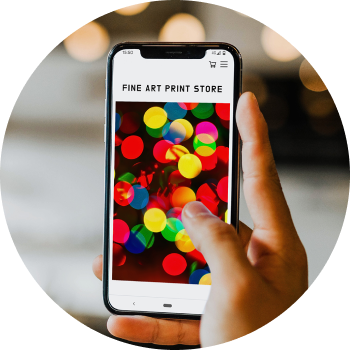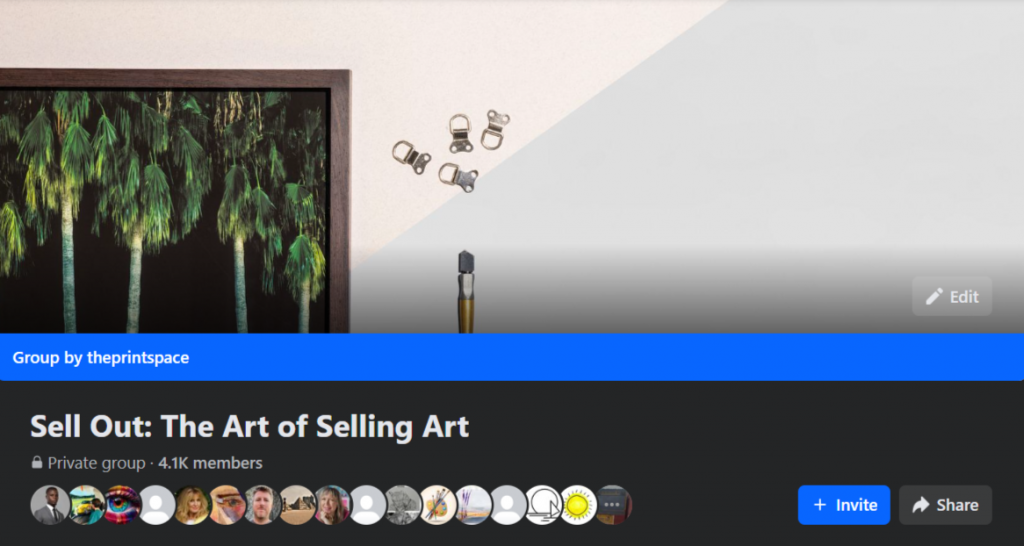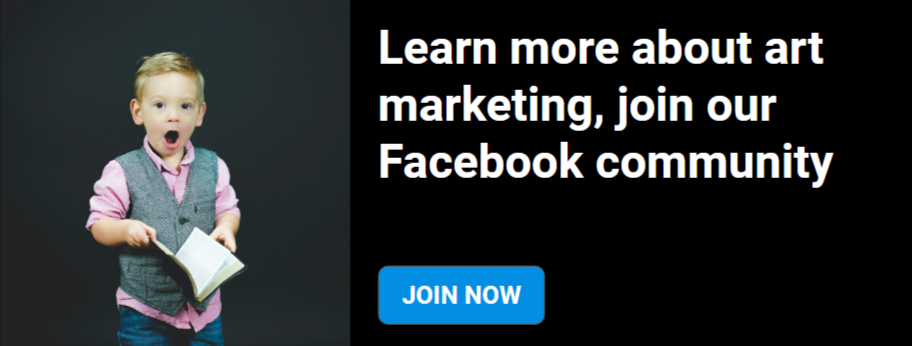
That’s lucky, because we’ve already answered them!
If you didn’t already know, we run a Facebook group called Sell Out: The Art of Selling Art.
In that group we run regular live videos where we cover all kinds of topics related to growing your online art sales and taking advantage of the boom in social commerce, which is just getting started. It’s perfect for artists to find a way to make a sustainable art career, so join the group and start learning new skills right now!
If you are new to the group, you might be asking questions that we have already covered and there is a ton of fantastic advice for you to get started with. We have hosted around 30 such live sessions since the launch of this group in May 2023 and this article will help you understand everything that we have discussed so far.
Print drop strategy
Why should I create scarcity and urgency with online art sales?
Social media is fast-moving. You see a post or a reel and if you don’t act on it right away then it goes away and is not shown to you again by the algorithm. Selling art on social media faces similar challenges. You need to ensure that your audience sees your posts and clicks through to your website. So in order to get some permanence out of this fleeting, transitory nature of social media traffic, you need to have built-in scarcity and urgency in your sales strategy.
You can watch this section of the video, between 5:48 and 7:34 to understand why scarcity and urgency are important when you sell art via social media. You can also read the transcripted segment here.
How do I create scarcity and urgency in my online art sales?
Running time-limited print drops is how you create urgency and scarcity around your art sales. All the elements in your timed drops should have the language of scarcity and urgency built in, making sure that your audience knows that they need to make a buying decision right now or they would miss this opportunity. Your emails, landing page, teaser posts and all other marketing content should emphasise on the limited time, limited availability of the artwork.
Watch this video between 13:11 and 16:23 to understand how to go about running timed print drops of your work. For a full transcript of this segment, read this article.
When should I start selling my art prints in timed drops?
There are no absolute rules to decide when is the right time to start running timed drops of your work. But there are some baseline metrics to keep in mind like your social media following and engagement rates, your choice of artwork, whether or not you have enough marketing content for the artwork you’re planning to sell and so on.
We answered this question in one of our AMA segments. You can watch the video between 8:14 and 11:50 to know how you too can decide if it’s the right time for you to start selling your art prints in timed drops. You can also read the full transcript of this segment here.
Should I sell open editions or limited editions?
The real question to ask here is what creates more urgency and pushes your audience to buy your art. There are use cases for both open editions and limited editions when it comes to online art sales. But when it comes to selling art via social media, time-limited art sales are the way to go!
We have delved into this topic in detail, talking about how social media influences your purchase decision and what should be your preferred sales strategy to navigate the changing landscape of social commerce. Watch this segment of our AMA between 9:16 and 13:09 to get the complete answer. Or you can read the full transcript of that segment here.
How do I increase my online art sales?
The first step to working out how to increase your online art sales would be to measure and analyse your existing art sales results against the benchmarks, i.e. against theprintspace’s published average traffic and conversion metrics that will tell you the areas you need to work on. Benchmarking is the main way to inform yourself of how well you’re doing, and to help you understand the problem areas and figure out the improvements you need to make in the way you are marketing your art or in your ecommerce store design. Otherwise you might be fumbling around in the dark and thinking that your sales aren’t that good or are great when the opposite might be true in relation to how other artists perform on average.
Watch this video from 3:31 to 7:38 to understand how to measure your print drop numbers with the industry benchmarks and then work towards improving your sales. For a full transcript of this segment, read this article.
If I do a print drop, can I sell the same artwork again in the future?
It all depends on how you word it when you talk about your print drop to your audience. If you sell a timed edition then we think the meaning of this is that this print, in the form you are selling it in, would only be available between the two dates/ times that make up the start and end date of the timed edition.
However if you publicise your print release as a timed drop, but a limited or open edition, you would not be precluded from selling it again (provided in the case of the limited edition that all the edition numbers did not sell out in the first timed drop). In this case we do recommend saying something like “I don’t know when this artwork will be available in the future”. So indirectly that means that the artwork will be available sometime in the future. We would leave a long interval, at least 9 months, but usually more than 12 months before you offer it again, otherwise the scarcity aspect of the timed drop might lose some credibility in the eyes of your engaged audience, who are the most likely print buyers.
One of our group members had a similar question. He was worried that he would end up wasting a collection of his images if he released them in the drop and they did not sell well. Watch this video from 7:05 to 8:09 to know what we answered!
How many print drops should I do in a year?
Planning the frequency of your drops is an important step but what’s more important is focusing on experimenting and taking some time to analyse what you learn from each drop. There are two distinct approaches to this and both can work; the print drop and the project drop. Print drops are shorter which means you can iterate faster and learn what works and what doesn’t with your audience and build on those learnings in the next drop. Project drops are great too, particularly if you are a strong social media storyteller.
We originally spoke about this in an AMA. However our thinking has evolved since we did, so instead of a link to the AMA video, here’s a link to our current thinking on this topic.
How many artworks should I sell in a timed drop?
We recommend selling only one artwork at a time, with some exceptions, when you’re running time-limited print drops of your work. The exceptions are cases where you’ve created two pieces of work that work really well as a set or if the artworks are connected strongly to a central theme or narrative. Increasing the number of artworks in a drop negatively impacts the conversion rate because the buyer has options to choose from, which makes the buying decision slightly difficult.
We have spoken about this in one of our AMA segments between 12:23 and 15:36. Watch it to understand how to plan the number of artworks you want to sell in your upcoming print drops. You can also read the transcript of the segment here.
Should I have a permanent collection in my online art store?
Permanent collections do not have the language of scarcity built in because by definition it means that your permanent collection is always for sale. However, in certain scenarios permanent collections can work really well for your online art sales when accompanied with time-limited drops.
Take a look at the section of our AMA video from 15:42 to 20:22 to get some insights into the success of permanent collections for artists. For a full transcript of the segment, read this article.
E-commerce platforms for art sales
Why is Shopify the best ecommerce platform for art sales?
Shopify offers the best ecommerce solutions for sellers in terms of facilitating and converting art sales. We highly recommend building your website on Shopify if you are serious about selling art online. Friction free checkout process, multiple payment options, shipping settings, extensive app store, easily customisable design are some of the benefits that Shopify offers. Watch this short 7-minute video summarising every reason why Shopify should be your go-to platform for art sales or read this article.
Social media content
How do I promote my art on Instagram?
Promoting your art on social media essentially comes down to telling a really interesting story about the artwork that can engage your audience, or provide some kind of context to help your audience understand and identify with it. You can talk about the background of your artwork, how and why you thought of creating this piece, and your motivations and inspirations for doing so. You could talk about the different skills you’ve learnt in the process, the challenges you had to overcome, or show the work in progress at different stages of completing the artwork. There are so many interesting ways you can talk about your work during a print drop.
Mathilde Morant (Viti Project), one of our group members, is working on a long-term project of making a watercolour painting of every lighthouse in Iceland. We spoke to her in one of our AMAs to brainstorm some ideas of how she could promote her project on Instagram and keep her audience engaged in the process. Watch this video segment between 25:10 and 32:03 to be a part of that conversation and also take some notes and get inspired to talk about your upcoming projects by following a similar framework. You can also read the full transcript of this segment in this article.
As an artist, how do I get more views for my Reels on Instagram?
There are two parts to this. First, you need a really strong hook to get someone to stop scrolling and start watching your reel. We call this a thumb stop moment which needs to happen in the first 2-3 seconds of your reel. Now that you have got them interested in your content, the second thing you need is an equally strong narrative to make sure they watch the reel till the end. Narrative is basically the story or the message you are trying to convey through your reel. So when a great hook comes together with a strong narrative, that’s when your reel goes viral and reaches more people.
We have reviewed a lot of reels in the group, highlighting what the hook and narrative is in each one. Here is a really great segment from one of our videos that summarises everything about making good reels. Watch the section between 20:55 and 24:18 or read this article for the full transcript of it.
How do I create a viral reel showing my artworks?
A reel has to have a good hook and a great narrative for it to go viral, that is, the number of plays/views exceeds the number of followers. There are many ways for you to achieve that using IG features such as trending audio, templates, video challenges and trends, quick cuts with music, filters, camera angles etc. Of course your content is key and plays a huge role in how successful your reel is but using these features with built-in hooks & narratives, you can package your reel really well for it to reach a lot more people than your followers.
Here’s a quick recap of us talking about how to create viral reels in this video segment between 1:06:15 and 1:08:04 or you can read the transcript here.
If you want to learn more about creating viral reels, then we would highly recommend reading these two articles. We have watched hundreds of reels to identify what makes a reel go viral:
How artists can grow their Instagram following
The BIG secret to selling art online
I am an artist, why should I have to do social media?
A lot of times artists are hesitant of using social media platforms because they are worried it is not authentic or genuine and they may need to put up a persona in order to build their following and promote their art. The idea of doing this makes them really uncomfortable and as a result, they end up not utilising the platform that has the power to transform their careers. We have always advised that the more authentic and genuine you are on social platforms, the higher your chances are to connect and engage with your audience.
As an artist, it has always been important for someone to communicate clearly some context to the work. In the age of direct to consumer selling (DTC) which is what social commerce is, then you are the person to do that. If it’s not going to be you that does it, then who will?
People identify with the artist as much as the art, and they find it interesting to understand the motivations for making the artwork. This has always been the case. They want to know your story, and if they do then they are more likely to want to support you by buying your art. Or let’s say it’s another reason people will buy.
However you can tell this story without actually featuring yourself, you can tell it in other ways, but explaining why you made a piece of work for example. So whilst you should be genuine and reveal something of your personality this does mean actually appearing in your Reels or on your feed if you want to stay more anonymous, or you’re just not comfortable on camera.
Watch the segment of this video between 23:03 to 27:41 to understand why it is absolutely essential for you to consider social media as your friend in this changing social commerce landscape. You can also read the full transcript of the segment here.
As a photographer, how do I create good content on Instagram?
Showing your creative process as a painting timelapse, the finer details of the brushstrokes, as a before-after video or in any other interesting way has been one of the most successful formats for reels. But photographers have often wondered how they too can tap into this successful format and grow their following with reels.
Watch this video segment between 31:39 to 33:57 to know how photographers can show their creative process via reels. For a full transcript of the segment, read this article.
Email marketing
Can I sell art through email?
Social media is transient in nature so with any engagement you get on your content you should try to make that person a follower, buyer or email subscriber. Your email list is your biggest asset because it is an owned marketing channel for you where you can communicate with your audience whenever you want and be assured that they will get your message. You are not dependent on any algorithm to show your content.
If you watch a clip from this video between 35:57 and 38:56, you’ll understand why building a mailing list is so important for your art sales growth. For a full transcript of this segment, read this article.
Why should I sell art through email?
When someone subscribes to your mailing list, it means they like your work and they want to hear from you about your upcoming print releases or exhibitions. And if you’re marketing your work in the right way then at some point they will also buy from you. So an email newsletter subscriber is a step to becoming a buyer in the future. It’s always much easier for someone to subscribe to an email newsletter than it is to make a purchase in the first place, so they can get to know you and feel more confident to buy.
You can watch the video segment between 21:49 to 26:24 or read the transcript here to understand why selling your art via email is actually the best strategy for you in the long-run.
How often should I send my newsletters?
There are no rules as such but basically you should send a newsletter when you have something interesting to say because that ensures good open rates on your future newsletters. If you send emails with little value-giving content, your subscribers may consider it as too boring or salesy and they may unsubscribe.
If you watch a clip from this video between 58:48 and 1:02:06, you’ll understand the importance of maintaining the right email frequency. For a full transcript of this segment, read this article.
Pricing strategy
How much should I sell my art for?
Setting up your art prices so that you make an average of 50-55% profit margin is the sweet spot to maximise profits. If you sell at lower prices, you are devaluing your art in the eyes of the consumer and getting into the dangerous territory of competing on cost. Buyers who buy art based on price are not the right kind of buyers. And if you sell at higher prices, you will start to restrict your sales.
Follow the link to read an article based on one of our AMAs with our views on how to set prices.
Should I sell framed prints of my art?
People who are cost-conscious buy unframed prints and then source a cheaper frame online. People who are time-poor but not as cost sensitive buy the framed print from you. And the premiums people are willing to pay for that convenience are actually very high, when it comes to framed vs unframed art.
Watch this video from 41:45 to 44:07 or read the transcript here to get some insights into the value of offering framed prints of your art.
Online store design
How do I increase the conversion rate for my online art store?
When you direct traffic from Instagram to your landing page, you want them to buy the print immediately and not wander off on your store, clicking multiple links and reading extra information that they do not need. Instead, the page design should encourage them to convert quickly. We recommend creating a highly focused page with a countdown timer on the top, details of the artwork being sold, delivery information and bright checkout buttons so your eyes are immediately drawn to them.
Watch our AMA where we take you through the ideal page design for a high-converting online art store. Check out the section of this video between 10:29 and 19:35 or read the full transcript in this article.
What makes a good design for an online art store?
The language of urgency needs to be all across your landing page if you are doing timed print sales. It’s really important to communicate the scarcity & urgency very clearly, through different elements on the page. Watch this 10 minute video where we take you through a good online art store design, step by step or read this article to get a quick summary of the video.
If you have any questions about art sales, pricing or want us to review your marketing strategy, do join the group! We regularly host AMA sessions where we answer questions from the group members and also invite artists to join us live for a conversation around their art sales strategy. You can also post any marketing related questions in the group to get an answer.
Social commerce is booming and we’re constantly talking about the best ways for artists to make the most of this opportunity. So join in!







